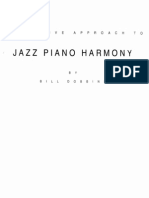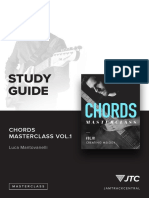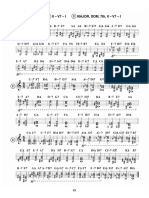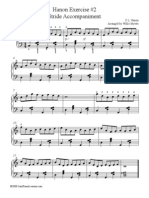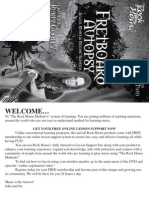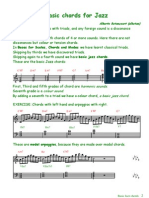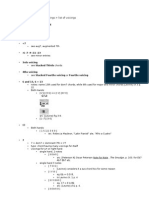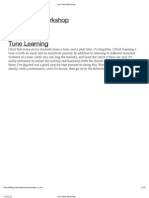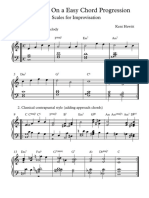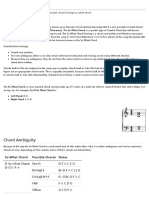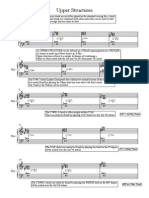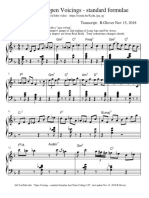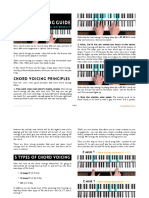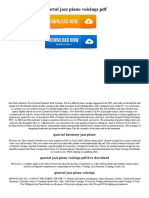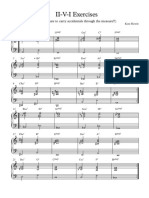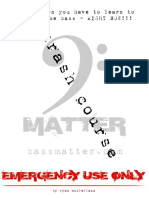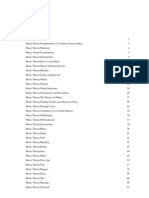Jazz Piano Workshop
Jazz Piano Workshop
Uploaded by
Louise JonesCopyright:
Available Formats
Jazz Piano Workshop
Jazz Piano Workshop
Uploaded by
Louise JonesCopyright
Available Formats
Share this document
Did you find this document useful?
Is this content inappropriate?
Copyright:
Available Formats
Jazz Piano Workshop
Jazz Piano Workshop
Uploaded by
Louise JonesCopyright:
Available Formats
32 bar aabc form please note that the melody is written in a simplified form, and is a guide only, embellishments
& syncopation are expected
Autumn Leaves
j > j > j >
major ii v i in b flat
mark@jazzpiano.co.nz
this indicates that the feel is swung not straight 8ths
medium A1
comping rhythm 1
for A sections minor ii v i in g only
bb c &
Am7( ! 5)
Cm7
b &b w 6
A2
b Cm7 b w & 10 b &b w 14
a locrian #2
major ii v i in b flat
. .
D7( # 5 # 9 )
c dorian
> . j
F7
f mixolydian b flat major e flat lydian
d superlocrian
F7
n #
Gm (maj7 )
.
. j > j > j >
B !maj7
j >
E !maj7
g jazz minor
minor ii v i in g
Am7( ! 5)
b &b 18
22
minor ii v i in g
Am7( ! 5) Cm7
D7( # 5 # 9 )
B !maj7
D7( # 5 # 9 )
Gm(maj7 )
E !maj7
. .
w w
bb w & &b
major ii v i in b flat
F7
. J
Gm(maj7 )
26
b
minor ii v i in g
minor ii v i in g
Am7( ! 5) Am7( ! 5)
B !maj7
D7( # 5 # 9 )
E !maj7
#
B !7
C7
major ii v in F
Gm7
30
bb . &
D7( # 5 # 9 )
g dorian e.g.
major ii v in e flat
Fm7
Gm (maj7 )
f dorian e.g.
( )
Modes for Autumn Leaves
34
mark@jazzpiano.co.nz
scales & modes are a group of notes, a pool if you like from which you can draw your ideas
& & &
bb bb bb
Cm7
c dorian mode (2nd mode of B flat major scale, or c major scale with lowered 3rd and 7th)
F7
36
f mixolydian mode (5th mode of B flat major scale, or f major scale with lowered 7th)
B !maj7
38
b &b 40
42
b flat major scale
E !
& & & & &
bb bb bb bb bb
e flat lydian mode (4th mode of B flat major scale, or E flat major scale with raised 4th)
Am7( ! 5)
a locrian #2 mode (6th mode of c jazz minor scale, or natural minor scale with lowered 5th)
D7( # 5 # 9 )
44
d superlocrian mode (7th mode of E flat jazz minor, also called altered and half whole scale)
Gm (maj7 ) Gm7 Fm7
46
g jazz minor scale (melodic minor ascending)
48
g dorian mode, or c mixolydian mode (same notes)
n b
C7
B !7
50
f dorian mode, or b flat mixolydian mode (same notes)
Jazz Swing Quavers
play this scale and articulation
52
mark@jazzpiano.co.nz
&b
12 8 c
now play this in 12/8 time
55
b & b 12 8 b &b c &b b
j j j j j j j w. J w w
Now add an accent to the off-beat note
58
> > > > > > > >
Now play the slurred notes at full value (don't shorten) but with less emphasis
61
} > }>} k > }> }>} k k k > }> k k k >
This is an exaggerated rough guide to jazz swing feel and phrasing note length, weight of accent etc are all open to personal interpretation the shape of the melody and use of different rhythms will also determine the articulation used The only real way to get an idea of jazz swing is by listening to recordings made by great players
Voicings For Autumn Leaves
64
mark@jazzpiano.co.nz
&
bb
Cm7
ww w w
F7
bb w & ww 66 w
68
B !maj7
ww w w w w w w
E !maj7
&
bb b b
n ww w w
Gm7
Am7( ! 5)
nw n# ww w
D7( # 5 # 9 )
71
&b &b
72
Fm7
C7
w # ww note: you may want to play w
Gm(maj7 )
this chord using f natural instead of f sharp, try it out!
B !7
Chords can be divided into 3 groups, major, minor, and dominant Learn to recognise a major ii v i progression & the qualities of the chords involved (m7, 7, Maj7) Learn to recognise a minor ii v i progression & the qualities of the chords involved (m7b5, 7(alt), Min7 Your chord must contain at least the 3rd and 7th (guide tones) Build your chord from either the 3rd or the 7th upwards (there are usually 2 voicings per chord) Avoid playing the root in your voicings Keep movement between chords to a minimum (just like J.S. Bach!!) Extend the m7 and maj7 chord to the 9th with the 5th Extend the dominant chord to the 13th using the 9th (omit 5th) Use alterations on the dominant chord especially in a minor ii v i
Nomenclature of jazz chords
mark@jazzpiano.co.nz
There are 3 types of chord group, major, minor, and dominant. When you are reading chord charts you will need to be able to recognise which symbol belongs to which group. Often beginning improvisers get confused between a dominant chord and a major chord, whilst only a semitone different, the function of the chord is ENTIRELY different.
Here are common ways major chords are written
73
bb & bb & bb & &b b
B!
B !maj7
B !J
B !M7
Here are common ways minor chords are written
77
C-
Cmin7 F9
C-7 F13 A
Cm7
Here are common ways dominant 7 chords are written
81
F7
Here are the 2 ways a half diminished chord is written
84
Am7( ! 5)
Please note that jazz use extensions such as 9th, and 13th rather than 2nd and 6th to imply that the interval is ADDED to the existing chord and doesnt replace a note. e.g. C9 means a C7 plus a 2nd, Csus2 would imply that the 3rd is replaced by the 2. A C6 chord is just a c triad with the 6 added, however a C13 is a dominant chord. Jazz musicians will usually play a C7 with either a 9th or 13th anyway, so C7, C9, & C13 are the same practically.
Blues scales for Autumn Leaves
86
what b B flat blues - you may wish to try this scale over autumn leaves, see you think! b &b n b 88
&
bb
G blues - This is a good blanket scale to use when your brain aches from thinking too much!
Change running exercises
90
mark@jazzpiano.co.nz
& &
bb bb b
Cm7
>> >> etc.
F7
94
B !maj7
B !maj7
98
&b
Cm7
1
Digital pattern exercises
1
102
bb n & b 105
108
&b
E !maj7
2
3 5 3 2 1
F7
1
Am7( ! 5)
2
1 etc.
D7( # 5 # 9 )
b &b & bb
Cm
3
Gm (maj7 )
110
b &b 112
B !maj7
4 5 7 5 4
F7
3 etc.
E !maj7
Jazz lines (ideas)
114
mark@jazzpiano.co.nz
bb & bb &
Cm7
Cm7
117
What makes a solo interesting?
n b b
3
n b
F7
b b
F7
B !maj7
B !maj7
Repetition, Sequence, Dynamics, Range (high, low etc), Accents, Rest and Silence, Rhythmic Variation Variety (but not too much), Blues scale, Tension and Release, Motifs Knowing where the guide tones are (3 and 7) Trills, Glissandos, Swoops, Staccato etc Emphasise pretty sounding notes, 7ths, 9ths, #4ths Always try to buiid your solo, tell a story and make it go somewhere Above all of this, the main thing you need to do is LISTEN, it helps swing feel, improvisation, style and generally helps you build a solid jazz vocabulary!
What do I do now?
Practise Swing rhythms over familiar scales Practice major 251 in both hands through cycle of 4ths, best choice Practice major 251 in left hands through cycle of 4ths, play 251 exercise in right hand practising swing rhythms Seperate Chords types and practise through cycle, chromatically and randomly until you know the chords quickly Practise minor 251 in left hand , best choice Practise minor 251 in left hand, play 251 exercise using Locrian #2, Superlocrian, and Jazz Minor scales Buy a real book and play chords from any tune making yourself fluent with your new jazz voicings Buy Jamey Aebersold backing tracks and play along either with chords & tune or try soloing over the changes too! Just play, be creative, listen and have fun playing jazz! There is a huge recourse of jazz tutorial material available to buy and study, or book a series of private lessons from a tutor, study at one of the jazz courses available in both Auckland based universities.
You might also like
- 25 Licks Vol. 1 PDFDocument52 pages25 Licks Vol. 1 PDFMartin Gureasko100% (10)
- A Creative Approach To Jazz Piano Harmony BookDocument128 pagesA Creative Approach To Jazz Piano Harmony BookDanylll100% (10)
- Jazz Piano Left Hand Techniques Complete Ebook PDFDocument11 pagesJazz Piano Left Hand Techniques Complete Ebook PDFAmina Salihu100% (2)
- Jazz Keyboard 1 Lesson 1-Dick GroveDocument88 pagesJazz Keyboard 1 Lesson 1-Dick GroveEdmilson Santana97% (32)
- Bartók at HarvardDocument227 pagesBartók at HarvardJorge Pérez100% (1)
- Modal Scales - Trumpet - LexcerptsDocument17 pagesModal Scales - Trumpet - LexcerptsLexcerptsNo ratings yet
- LM Chordsmasterclass Vol1 PDFDocument85 pagesLM Chordsmasterclass Vol1 PDFKevin100% (2)
- II V I PianoDocument3 pagesII V I PianoIago Edlstn100% (4)
- 20 Pianists, 20 Licks: B B B B B B B BDocument9 pages20 Pianists, 20 Licks: B B B B B B B BJorge Eduardo Velosa100% (7)
- Encyclopedia of Two Hand Voicings PDFDocument12 pagesEncyclopedia of Two Hand Voicings PDFJey Rotier80% (10)
- A Comping Workbook Dec 2012 Small (合併檔)Document155 pagesA Comping Workbook Dec 2012 Small (合併檔)紀亮竹91% (22)
- Hanon2 StrideDocument1 pageHanon2 StrideCarmeraNo ratings yet
- Rusty Cooley - Fretboard Autopsy 2 PDFDocument32 pagesRusty Cooley - Fretboard Autopsy 2 PDFFractus Anomalii100% (8)
- Workbook PDFDocument157 pagesWorkbook PDFRocio ChavezNo ratings yet
- Comping 2Document3 pagesComping 2pikbeb65100% (1)
- Basic Jazz Chords PDFDocument7 pagesBasic Jazz Chords PDFEric RamirezNo ratings yet
- Jazz Piano Skills (Music 15) : TH TH THDocument2 pagesJazz Piano Skills (Music 15) : TH TH THaliscribd4650% (2)
- Paddy Milner Creative Ideas For Your Blues Shuffle 1Document1 pagePaddy Milner Creative Ideas For Your Blues Shuffle 1Javier Montañes100% (1)
- Piano JazzDocument18 pagesPiano JazzGabriel SoriaNo ratings yet
- Chord Voicings List For The PianoDocument12 pagesChord Voicings List For The PianoIslam Guemey50% (4)
- Piano-Voicings 2&1 HandDocument33 pagesPiano-Voicings 2&1 Handazerty2009-201080% (5)
- Minor-251 Lesson SupplementDocument5 pagesMinor-251 Lesson SupplementAlex SimonianNo ratings yet
- Stride PianoDocument4 pagesStride PianopicchiookNo ratings yet
- Jazz Piano VoicingsDocument1 pageJazz Piano Voicingshaykminasyan100% (2)
- II V I Rootless LH Piano Voicings PDFDocument3 pagesII V I Rootless LH Piano Voicings PDFZachary BarnesNo ratings yet
- Jazz Piano WorkshopDocument18 pagesJazz Piano Workshop8989001100% (8)
- Minor 251 Progression in All 12 Keys: Type A Voicings Type B VoicingsDocument2 pagesMinor 251 Progression in All 12 Keys: Type A Voicings Type B VoicingsGabriel SoriaNo ratings yet
- Major II V I Basic Piano VoicingsDocument1 pageMajor II V I Basic Piano Voicings김형규100% (1)
- Jazz VoicingDocument5 pagesJazz VoicingGodwin Ariwodo100% (2)
- Exercises Hewett 2019 Easy Chord ProgressionDocument6 pagesExercises Hewett 2019 Easy Chord ProgressionArnold RabinNo ratings yet
- Essential Jazz Piano Phrases PDFDocument202 pagesEssential Jazz Piano Phrases PDFJuan MonteroNo ratings yet
- David Bruce - Block ChordsDocument2 pagesDavid Bruce - Block ChordsMark KulobaNo ratings yet
- Jazz Piano Improv 1Document3 pagesJazz Piano Improv 1fatcode27No ratings yet
- Collection of Two Hand VoicingsDocument1 pageCollection of Two Hand VoicingsTheWurst123No ratings yet
- Piano CompingDocument10 pagesPiano CompingRolieNo ratings yet
- So What Chord - The Jazz Piano SiteDocument5 pagesSo What Chord - The Jazz Piano SitetoniNo ratings yet
- Jazz Piano VoicingsDocument5 pagesJazz Piano VoicingsLamarr KSterling-Gay75% (4)
- Jazz Piano Roadmap PDFDocument1 pageJazz Piano Roadmap PDFMbolafab Mbolafab0% (1)
- Joy of Improv Vol 1 Excerpt PDFDocument4 pagesJoy of Improv Vol 1 Excerpt PDFIgorNo ratings yet
- Upper StructuresDocument2 pagesUpper Structuresbobbirch73100% (4)
- Berklee Pop KeyboardDocument3 pagesBerklee Pop KeyboardDiegoArmandoMurillo0% (1)
- Patterns Jazz Kenny Barron - Cm7-F7-Bbmaj7Document2 pagesPatterns Jazz Kenny Barron - Cm7-F7-Bbmaj7diegob_rc100% (1)
- How To Practice Scales Bonus Full Score PDFDocument1 pageHow To Practice Scales Bonus Full Score PDFMarcos Paulo Campos100% (2)
- Jazz Piano LicksDocument10 pagesJazz Piano LicksanthonymartijaNo ratings yet
- Rootless XDocument3 pagesRootless XAnonymous 26kU5IvyKS100% (1)
- Jazz PianoDocument3 pagesJazz Pianovijaymusic880% (2)
- 'The Chord Voicing Guide' by Julian BradleyDocument11 pages'The Chord Voicing Guide' by Julian BradleyFabian Vazquez Pereira100% (1)
- Quartal Jazz Piano Voicings PDFDocument2 pagesQuartal Jazz Piano Voicings PDFMariano Trangol Gallardo17% (6)
- 2 Handed Minor 251 SupplementDocument2 pages2 Handed Minor 251 SupplementMbola Rabemananjara100% (1)
- 4 Example 6Document3 pages4 Example 6salomeeaf100% (1)
- JPS Top 22 Favorite Two-Hand Voicings: & ? WWW# B WWBDocument7 pagesJPS Top 22 Favorite Two-Hand Voicings: & ? WWW# B WWBLaurindo de CastroNo ratings yet
- CompingDocument10 pagesCompingGiancarlo Martino100% (1)
- Stride PianoDocument40 pagesStride PianoMáté SzabóNo ratings yet
- II-V-I Drills 2 PDFDocument6 pagesII-V-I Drills 2 PDFArchit Anand100% (2)
- Jazz Pianists TimelineDocument1 pageJazz Pianists TimelineDavid Mesquitic100% (1)
- Latin Piano Practice Sessions Volume 1 In All 12 Keys: Practice SessionsFrom EverandLatin Piano Practice Sessions Volume 1 In All 12 Keys: Practice SessionsRating: 5 out of 5 stars5/5 (1)
- Progressive Rock Organ Practice Sessions Volume 1 In All 12 Keys: Practice SessionsFrom EverandProgressive Rock Organ Practice Sessions Volume 1 In All 12 Keys: Practice SessionsNo ratings yet
- Scot Ranney's Jazz Piano Notebook, Volume 2, "Latinesque" - Jazz Piano Exercises, Etudes, and Tricks of the Trade You Can Use TodayFrom EverandScot Ranney's Jazz Piano Notebook, Volume 2, "Latinesque" - Jazz Piano Exercises, Etudes, and Tricks of the Trade You Can Use TodayRating: 4 out of 5 stars4/5 (1)
- 60 Of The Funkiest Keyboard Riffs Known To MankindFrom Everand60 Of The Funkiest Keyboard Riffs Known To MankindRating: 5 out of 5 stars5/5 (1)
- 100 Ultimate Jazz Riffs for Piano/Keyboards: 100 Ultimate Jazz RiffsFrom Everand100 Ultimate Jazz Riffs for Piano/Keyboards: 100 Ultimate Jazz RiffsRating: 3.5 out of 5 stars3.5/5 (3)
- 100 Ultimate Blues Riffs for Piano/Keyboards, the Beginner Series: 100 Ultimate Blues Riffs Beginner SeriesFrom Everand100 Ultimate Blues Riffs for Piano/Keyboards, the Beginner Series: 100 Ultimate Blues Riffs Beginner SeriesNo ratings yet
- M.I.T. - The Overtone Series PDFDocument28 pagesM.I.T. - The Overtone Series PDFMatia CamporaNo ratings yet
- Upper Structure Triades and Slash ChordsDocument5 pagesUpper Structure Triades and Slash ChordsTiago Cordeiro100% (1)
- 84 ModesDocument8 pages84 Modespineville2530No ratings yet
- Bass Crash Course PDFDocument24 pagesBass Crash Course PDFPedro Alberto Rubio RosaNo ratings yet
- Bassic LessonsDocument40 pagesBassic LessonsBayo David OluwatobiNo ratings yet
- MODES FOR GUITAR 2016 Puguh Kribo PDFDocument25 pagesMODES FOR GUITAR 2016 Puguh Kribo PDFIreneNo ratings yet
- Guitar Lessons - Chromaticism PDFDocument3 pagesGuitar Lessons - Chromaticism PDFMarco Caputo100% (1)
- Folk Song and The ConstructionDocument388 pagesFolk Song and The ConstructionSasha PozelliNo ratings yet
- Introduction To Modes and Modal TheoryDocument13 pagesIntroduction To Modes and Modal Theorypeterosuna100% (1)
- Tom Quayle: Fusion Essentials Vol.1Document3 pagesTom Quayle: Fusion Essentials Vol.1Di AlmeidaNo ratings yet
- Circle of FifthsDocument1 pageCircle of Fifths54321anibalgarcia100% (1)
- Music Theory Ethiopian MusicDocument4 pagesMusic Theory Ethiopian MusicLéa Ciechelski100% (5)
- Musical System of Ancient GreeceDocument8 pagesMusical System of Ancient GreeceAntonella Mg Digiulio100% (1)
- Jazz Guitar: by Victor SaumarezDocument5 pagesJazz Guitar: by Victor SaumarezAntonio Caballero100% (1)
- Music TheoryDocument80 pagesMusic TheoryAravind Selvapalani100% (6)
- Phil Ward 2008Document80 pagesPhil Ward 2008Henrique Weege100% (1)
- Music Theory The TL DR Version (2.0)Document117 pagesMusic Theory The TL DR Version (2.0)Anthony0% (3)
- 2016 Annual Teacher Plan Pace SetterDocument16 pages2016 Annual Teacher Plan Pace SetterRonald PresherNo ratings yet
- CochraneDocument46 pagesCochraneCynthia RiveraNo ratings yet
- Refutation of The Lydian Theory by Brett Clement PDFDocument121 pagesRefutation of The Lydian Theory by Brett Clement PDFThomas Costello100% (2)
- E9 Modal Scales - E9modalmemDocument31 pagesE9 Modal Scales - E9modalmemkdkdkd100% (1)
- Modal Scales - Euphonium (Bass Clef) - LexcerptsDocument17 pagesModal Scales - Euphonium (Bass Clef) - LexcerptsLexcerpts0% (1)
- Bass Guitar Scales Encyclopedia Fast Reference For The Scales You Need in Every Key by Andy Schneider (Schneider, Andy)Document124 pagesBass Guitar Scales Encyclopedia Fast Reference For The Scales You Need in Every Key by Andy Schneider (Schneider, Andy)Eleazar Reyes CentenoNo ratings yet
- The Guitar Technique BookDocument31 pagesThe Guitar Technique BookYohan ZeitounNo ratings yet
- List of ScalesDocument5 pagesList of ScalesJim MercerNo ratings yet

